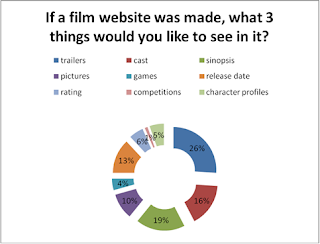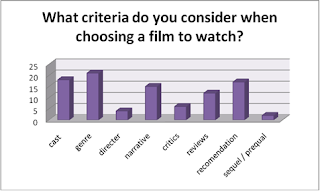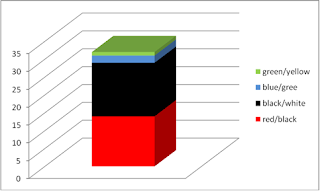- The teaser trailer being too long. At 1:55, our aim is to make it below 1:30. This is our target because other teaser trailers we have analysed advertising well known films are commonly 30-90 seconds.
- The resolution of the screen is incorrect, a minor mistake, but makes some images noticeably out of scale.
- During Molly's voice over, there is a slight hiccup in her grammar, that we recently only just noticed. The wording: "several news paper reports suggest these disappearance" is incorrect, and should be plural, to sound like "these disappearance's".
Wednesday, 8 December 2010
Initial Teaser Trailer
Tuesday, 7 December 2010
Rough Cut 1
Sunday, 5 December 2010
Editing Software
"Manufacturer's Description-
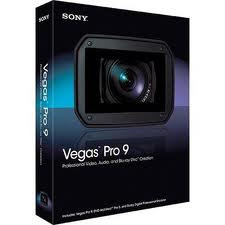
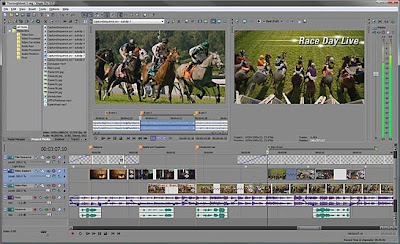
Sunday, 28 November 2010
Monday, 22 November 2010
Sound track
Because our film is for the purpose of a media A level, the funding is not necessary, and getting a custom soundtrack is only possibly if we make it. It would be possibly to make a music sound track, but unfortunately the technology available to us is too novice. The only composing program available to our school is Sibelius, which is technically good for rhythmic composition, but not instrumentally. I have experienced this software at GCSE music and found it easy to work with, but it gave a poor automated sounding product as an end result.
The alternative method would be to use a soundtrack already created.
The sound the group and I want is a type that denotes the horror genre, this in musical terms requires the songs to be in a minor chord, as this chord type projects a sense of sadness, pain and anger. The alternative chord type is major, which projects a happy joyful moment, which would be ironic and not doing the job we initially selected.
The song we have chosen to be part of our soundtrack and to appear in the teaser trailer is called 'Final Hour', by X Ray Dog...
http://www.youtube.com/watch?v=Jo2_s7J8-JA&feature=player_detailpage
The track is a slow tempo piece, which is of a minor chord like we initially selected. However, the piece is known and renowned as a intensifying movement that is themed very much around the action genre. But with action come violence, which is the main theme we as a group want to show and we all feel this piece of music does exactly that.
Locations of filming

Sunday's Child Font and Editing

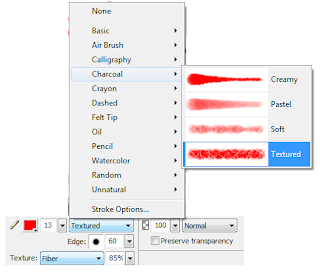 The settings I chose to edit the text first was under the pain brush tool, where I played with the properties, where I could get really specific details. Above is an image of the specific settings. The Image below is the paint brush using black paint.
The settings I chose to edit the text first was under the pain brush tool, where I played with the properties, where I could get really specific details. Above is an image of the specific settings. The Image below is the paint brush using black paint.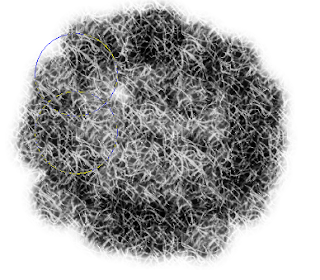



Wednesday, 17 November 2010
'Sunday's Child' Title

Tuesday, 16 November 2010
Permission
Actor Profiles
Molly Bell- Molly Bell
Molly is familiar with acting as she attends weekly to a Drama school at the Derngate in Northampton. We as a group know Molly through our team member Giuliano Rapoz, who also is part of this Drama School. At the age of 15 she is studying her GSCE's, and is willing to give her time to us.
Annie Bell- Keira Berry
Keira plays Molly's younger sister in the film. She also attends drama school where she was scouted to play a part in a Vodafone Television commercial. The group knows Keira through Lewis and myself, as we know Keira from Whittlebury Primary school. Aged 11 and now attending Sponne secondary school she is mature for her age and is a promising hope to be part of a professional media filming production.
Molly's Mum- Tania Tillyer and Molly's Dad- Bryan Tillyer
We have Lewis's parents playing Molly's parents, as they both are comfortable being filmed on camera, and are supportive of Lewis's studies. Along with this we can use the Tillyer household as the Bell's. We are planing on filming a few shots when Molly is carrying out an investigation of the child kidnaps. Bryan and Tania are ideal for the job because they are free during the weekends for us to film, and fit the right age category for stereotypical parents of Molly's age.
Priest- Lewis Tillyer
Lewis has volunteered to play the role of the priest. Although he is a teenager he has a mask to cover his face, and so the identity is kept secret. Lewis is not old enough to be a priest, and if we were to make the film we would of chosen someone different to play the part. Lewis is aged 17 and has no experience acting, but nonetheless, he is confidently in playing the part of the mass murdering paedophile priest.
Dead Children- Kyle Tillyer and Zini Rapoz
These two kids are young (11 &12), and their parts in the teaser trailer is to play the role of dead children in the playground. These children just about fit the age range we want. Zini is team member Giuls' younger brother, like wise with Kyle and Lewis. Having younger siblings feature in the teaser trailer is good, as we can directly tell them what we want without any hassle. Giuls' brother also attends the Derngate Drama classes, and therefore is comfortable with acting, whilst Lewis' brother carries through the same confidence.
Monday, 15 November 2010
Updated Storyboards

Friday, 5 November 2010
Shooting Schedule
The Tables told us When we were filming, Where the filming would take place, What we needed and Who we needed to film. The shooting schedule shows our organisation as a team and that we have our time management sussed out.
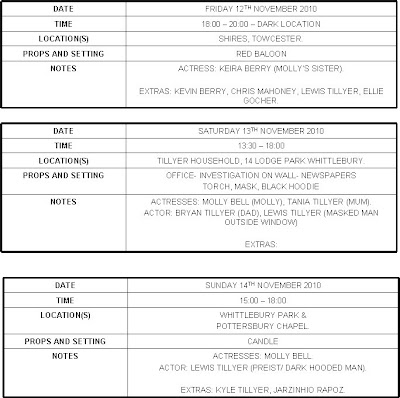
Thursday, 4 November 2010
Group Presentation / Pitch

Film Plot- Sunday's Child
- Opens with a young girl running from an un seen threat and eventually getting brutally killed by a hooded character.
- Credit Sequence
- Few months later, the village (the girl killed was from) are throwing a fete.
- Little girl goes missing
- Police are investigating, forensic science teams, etc. But they cannot trace the girls whereabouts or the killers.
- Girls parents begin arguing more and more and the mother has turned to drinking.
- Girls older sister cant stand problems at home anymore and as police cant find anything she begins to create her own investigation.
- Girl begins to investigate around the village, asking citizens what they saw happen at the fete, where they were etc. Uses microphone to record investigation
- Other incidents begin to occur- a small group of children (all similar in age to the previous) go missing from the village playground.
- Police get nowhere with investigation.
- Molly finds security in her boyfriend, her parents disapprove of her having a boyfriend, arguments occur between parents and molly, they blame her for daughters disappearance.
- Whilst investigating one day, few days after playground incident, molly is walking down a road in the village and senses someone/ something watching her, making her insecure, when she turns to see what’s there she sees no one. As she turns back she bumps into the village priest. He apologises and comments on molly’s sisters disappearance and how he hasn't seen them both in church for several months. Molly smiles and carries on walking.
- Molly arrives at the playground and looks around for any signs of evidence. She cant find anything. As she goes to leave she notices a large adult size shoe print of some mud on the path. She quickly takes a photo and returns home.
- Whilst looking at the shoe print image on the computer, struggling to find any clues of suspects from it, she sits back in stress. As she does so, she notices a pattern of mud on a flyer in a pile on her desk. She suspiciously picks up the flyer, for it to reveal the same footprint as the image. Unaware of the priest watching her outside the window (masked)
- Flashback- when molly bumped into the priest, dropped some flyers and the priest accidentally stepped on one.
- Molly quickly grabs her bag and microphone and runs out of the house (night time).
- Molly runs to the village church, the lights are on inside unusually and the door is unlocked.
- Molly creeps in quickly, looking around for children and the priest.
- Suddenly as she walks round the corner and into the main church hall a horrible smell hits molly and she sees all the missing children, all dead in the church pews, etc.- ‘Sunday school’ style.
- Molly runs to her sister to see if she is alive- she doesn't move suggesting she's dead .
- As she stands in the church, breathing deeply and beginning to cry, the priest appears from shadows and begins to loudly preach and pray, cornering molly.
- As the priest leans into her, raising his blood-stained hands, molly takes out a bible from behind her back and smacks the priest around the head.
- As the priest crouches in pain, molly pushes past him and begins to run for the door.
- Just as molly is about to reach the door, it swings open and a crowd of the village adults swarm in.
- Molly is relieved and quickly reveals how the priest is the killer and they have found him, however, the adults all ignore her and continue to walk towards her, forcing her back into the church , whilst chanting prayers.
- Molly begins to panic and scream- “what's wrong with you?”, “he killed them all!”, “he’s right there! Why won’t you help me?”
- Adults all crowd around molly and the priest leans in and sedates her, she screams and then blacks out.
- As she wakes up, slightly dazed at first, she notices she is outside and all the adults are down below her. Molly looks around and has realises she has been crucified. Molly screams in pain and disbelief of it all.
Wednesday, 3 November 2010
Monday, 1 November 2010
External factors
- The Weather- This is a problem that is entirely out of our control. If it snows, it snows, however we will just have to cope with this and carry on with the filming. If the conditions are so bad that we're not able to meet as a group, then we will have to re-schedule our shooting to another date.
- Illness- Being ill is another thing to consider, as it depends on who it is. If one of the scheduled actor's/ actresses are ill then we will have to amend our planning of shooting dates to another time. If one team member is off ill, then I think the rest of the team must carry on as we have limited time with our actress (Molly Bell).
- Technology- With our non-existent budget we will have to make do with the technology we already have. An advantage of this would be that we are already familiar with the hardware/software, and so we can easily reach our penitential as a group if we work together. Creating science fiction effects/ live mix special effects is our of our capability. An example of the software would be 'Magix Video Pro X 2.0'. Editing software is something that every has in our group. HD video cameras, SLR camera's, Tripod's, laptops etc are found around the groups personal belongings.
- Setting- The places where we are filming are'nt the most spectacular, but whilst planning our production and narrative we would have an understanding of where to film. For example permission may hinder our chosen location, and so we would have to of chosen a realistic location.
Wednesday, 27 October 2010
SUNDAY'S CHILD - FILM SYNOPSIS
Sundays Child
Waltonbury, a small and secluded rural village on the outskirts of Hertfordshire, has always been recognised for its close knit community where everybody knew everyone and secrets were unheard of.
That is until the first child went missing…
She’s young. She’s beautiful. Her corpse, laid bare in the bypass betrays no secrets, that is except for strange numbers seared onto the inside of her cold lifeless hand.
The first body was a warning.
When Molly, a teenage girl living in the village discovers that her sister goes missing, terror spreads through the isolated town. Molly begins to fear that a brutal serial killer is stalking the village streets; a shadowy madman without mercy or apparent motive. How could this be happening in a place so serene?
The final body…might be hers.
With the death toll rising, Molly races to expose a deadly conspiracy and the sadistic killer at its heart, and every move she makes could be her last.
Tuesday, 26 October 2010
Film Institution
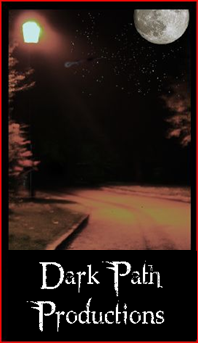
The image that we took ourselves was taken at nigh time. We timed this shot for the dark effect, as it ties in with the horror theme. It also ties in literally with the name; ‘Dark Path Productions’.
Our aim was to collect a few shots on the camera, preferably a long shot of a narrow road along with a street lamp.
With Lewis taking the shot on a high quality SLR camera and myself directing him we were able to collect the shot we aimed for.
In this image we can see:
- 'Dark Path Productions' - font style=Northwood High
- An over exaggerated moon,
- A clear nights sky with shining stars,
- An animated shooting star/ Flying comet,
- A path/ road going into the darkness,
- A shining street lamp revealing the path/ road curve into the distance, and
- Trees on both sides of the road.
The moon has a good presence to the logo, as it is a very large object that obits earth, it has only been explored by few people and has much more to show then what we already know. The fact that it is a full moon adds superstition. All these facts alone denotes the personality of the Production Company; mysterious and superstitious, linking to the horror genre.
The clear night sky lets us view the over sized moon, as well the shooting star. The clear sky suggests a clear successful journey for the production company.
A shooting star is a special sight, as it is rare to see due to covering clouds and unpredictability. When a shooting star appears people praise it, like it is a pleasure to see. These facts all boost the reputation of the production company, as a special figure within the filming industry.
Below all the fantasy features is a path, lit up first by a street lamp, but then travels alone into the distance. This has a literal connection towards the name and a connection to the typical narrative structure of a horror. From the characters point of view the light symbolizes the equilibrium, but then after that comes the inevitable disruption. After the disruption comes the recognition, where another light source shines the path. After the recognition it is the protagonists responsibility to chose the right path to get to that final street lamp. The character may use sense and look up for answers, where the stars may direct the character to that happy ending. A risky decision that is rarely completed by the protagonist in horror movies.
The trees are either side along the path, which suggests that character that takes this journey can't be escaped from, as the arms of the trees are keeping the character within the path.
The dark scheme is an aspect of 'Pathetic Fallacy' where the human emotions are effected by the visual appearance of nature. The dark night adds superstition and cautions of what maybe ahead.
The name 'Dark Path Productions' is a recognisable name, as Alliteration is used.
Target Audience Profile
Wednesday, 20 October 2010
What I do when analysing an extract!!
Camera shot is the amount of space that is seen in one shot or frame. Camera shots are used to demonstrate different aspects of a film's setting, characters and themes. As a result, camera shots are very important in shaping meaning in a film. Reviewing the examples on the right hand side of this page should make the different camera shots clearer.
Shot Types:
- An extreme long shot contains a large amount of landscape. It is often used at the beginning of a scene or a film to establish general location (setting). This is also known as an establishing shot.
- A long shot contains landscape but gives the viewer a more specific idea of setting. A long shot may show the viewers the building where the action will take place.
- A full shot contains a complete view of the characters. From this shot, viewers can take in the costumes of characters and may also help to demonstrate the relationships between characters. For more information on costumes and acting refer to Chapter 4.
- A mid contains the characters or a character from the waist up. From this shot, viewers can see the characters' faces more clearly as well as their interaction with other characters. This is also known as a social shot
- A close-up contains just one character's face. This enables viewers to understand the actor's emotions and also allows them to feel empathy for the character. This is also known as a personal shot.
- An extreme close-up contains one part of a character's face or other object. This technique is quite common in horror films, particularly the example above. This type of shot creates an intense mood and provides interaction between the audience and the viewer
- A bird's eye angle is an angle that looks directly down upon a scene. This angle is often used as an establishing angle, along with an extreme long shot, to establish setting.
- A high angle is a camera angle that looks down upon a subject. A character shot with a high angle will look vulnerable or small. These angles are often used to demonstrate to the audience a perspective of a particular character. The example above demonstrates to us the perspective or point of view of a vampire. As a viewer we can understand that the vampire feels powerful.
- An eye-level puts the audience on an equal footing with the character/s. This is the most commonly used angle in most films as it allows the viewers to feel comfortable with the characters.
- A low angle is a camera angle that looks up at a character. This is the opposite of a high angle and makes a character look more powerful. This can make the audience feel vulnerable and small by looking up at the character. This can help the responder feel empathy if they are viewing the frame from another character's point of view.
- A crane is often used by composers of films to signify the end of a film or scene. The effect is achieved by the camera being put on a crane that can move upwards.
- A tracking shot and a dolly shot have the same effect. A tracking shot moves on tracks and a dolly shot is mounted on a trolley to achieve the effect in the example above. This camera movement is used in a number of ways but is most commonly used to explore a room such as a restaurant. By using a tracking shot or a dolly shot the composer of a film gives the viewer a detailed tour of a situation. It can also be used to follow a character.
- Panning is used to give the viewer a panoramic view of a set or setting. This can be used to establish a scene
EDITING-
- A Straight cut break from one shot to the next. Cuts carry the
continuity of action forward in a straightforward manner, from action to action or place to place. - Jump cuts are confusing cuts from one shot to the next that do not
follow the obvious rules of cause and effect. These cuts are usually used to disrupt the
audience’s attention in order to create shock. - Fade outs show the screen fade from an image to a black screen.
- Fade ins show the screen fade from black to an image. Both fade-ups
and fade-downs are used to suggest the passage of time and generally work to give
the audience a chance to take a breath in preparation for the next scene. - Dissolves edits show one image slowly disappear as a new image is
introduced. Dissolves are used to indicate the end of one event and the beginning of
a new event or scene. - A Wipe edit is used to show one part of the screen literally wipe over the rest of the
screen. One image disappears as it is replaced by a new image. This kind of edit
is not often seen in movies, largely because it looks comic-bookish.
Diegetic Sound- Sound whose source is visible on the screen or whose source is implied to be present by the action of the film:
- voices of characters
- sounds made by objects in the story
- music represented as coming from instruments in the story space ( = source music)
Diegetic sound can be either on screen or off screen depending on whatever its source is within the frame or outside the frame.
Non-Diegetic- Sound whose source is neither visible on the screen and has not been implied to be present in the action:
- narrator's commentary
- sound effects which is added for the dramatic effect
- mood music
MISE EN SCENE-
French for - PUT IN THE FRAME'
Lighting-
- The intensity, direction, and quality of lighting have an effect on the way an image is perceived. Light and shade can emphasise texture, shape, distance, mood, time of day or night, season, glamour and it affects the way colors are rendered.
Types of lighting:
- Low Key
- High Key
- Under lighting
- Top lighting
- Back lighting
Colour and Connotations-
- Red - Energy, war, danger, strength, power, determination as well as passion, desire, and love.
- Pink - Signifies romance, love, and friendship. It denotes feminine qualities and passiveness.
- Brown - Suggests stability and denotes masculine qualities.
- Orange - Combines the energy of red and the happiness of yellow. It is associated with joy, sunshine, and the tropics.
- Gold - Evokes the feeling of prestige. The meaning of gold is illumination, wisdom, and wealth.
- Yellow - Is the color of sunshine. It's associated with joy, happiness, intellect, and energy.
- Green - Is the color of nature. It symbolizes growth, harmony, freshness, and fertility.
- Blue - Is the color of the sky and sea. It is often associated with depth and stability. It symbolizes trust, loyalty, wisdom, confidence, intelligence, faith, truth, and heaven.
- Purple - Combines the stability of blue and the energy of red. Purple is associated with royalty.
- White - Is associated with light, goodness, innocence, purity, and virginity.
- Black - Is associated with power, elegance, formality, death, evil, and mystery.
Props-
Objects make up the scene, and when creating a set the director must decide on the Props, as each prop can hold a connotation.
For example:
- A gun- Suggests Violence, Anger and Pain.
- A rose- Suggest Love, Passion and Romance.
- A Football- Suggests Fair play, Respect and activeness.
- A Baseball bat- Suggest Protection, Anger and Violence.
The style and Colour of hair builds a personality of a Character.
Men- Style:
- Short= A clean, professional and well looked after person.
- Long= Lazy and Doesn't pay attention to looks.
Woman- Style:
- Short= Masculine and Modern.
- Long= Traditional and feminine.
- Straight= Pure and innocence.
- Curly= Complicated and Busy.
Clothing-
This factor is important because it can build a strong suggestion of the character personality. Types of clothing can carry out different connotations. Sub-Cultures, Social class, Regional Identity, Ethnicity, Gender and Sexuality can create a characters representation, which can create an opinion for the audience, and can create an individual identity for each character.
- Sub-Cultures- Chavs wear baggy and sporting clothes, Goths wear dark style clothing.
- Social Class- Depends on the exspense of clothes. higher wear designer, middle wear casual clothes bought in regualar high street stores, and working wear second hand, damaged and old clothes.
- Regonal Identity- People tend to wear clothes that are suitable for their living environment. People who live in the country and are into agreculture wear thick sway clothes, whereas in london and city's clothes can vary in style because there tends to be split of sub-cultures, and so clothes vary.
- Ethnicity can be represented through traditional clothing that can be recognised easily, for example and Turban symbolises religion and a eastern descent.
Position within Frame
Selecting where to place the character is the directors job. Each character has a level of importance, and selecting where to put them in the cameras frame gives them a sense of identity, and makes things clear to the audience who are the main characters they are meant to focus on.
CLASSIFICATION
- Language
- Violence
- Horror
- Sex
- Drugs
- Nudity
- Imitable technique
- Tome
- Discrimination/bigotry
- Realism within fantasy

- If a work is particularly suitable for a pre-school child to view alone, this will be indicated in the Consumer Advice.

-Unaccompanied children of any age may watch. A ‘PG’ film should not disturb a child aged around eight or older. However, parents are advised to consider whether the content may upset younger or more sensitive children.

- The ‘12A’ category exists only for cinema films. No one younger than 12 may see a ‘12A’ film in a cinema unless accompanied by an adult, and films classified ‘12A’ are not recommended for a child below 12. An adult may take a younger child if, in their judgement, the film is suitable for that particular child. In such circumstances, responsibility for allowing a child under 12 to view lies with the accompanying adult.
- The ‘12’ category exists only for video works. No one younger than 12 may rent or buy a ‘12’ rated video work.



Tuesday, 19 October 2010
STUDY OF NARRATIVE STRUCTURES
Toderov's Theory
Toderov's theory outlines 5 key stages to a basic storyline structure. Often renowned as the 'Classic' storyline as it's used in so many popular films.
1. Equilibrium introduced
2. Disruption of the Equilibrium
3. The Recognition of the Disruption
4. Attempt to repair Disruption
5. Reinstatement of the Equilibrium
http://www.writework.com/essay/media-writing-and-todorov-s-theory
Propp's Theory
This theory was developed by Vladmir Propp, based on the work of the Russian Formalists. Propp used Russian Folktales as the basis for his theory but it can be applied to all types of fiction as well as many movies.
7 Character types:
- The hero (seeks something)
- The villain (opposes the hero)
- The donor (helps the hero by providing a magic object)
- The dispatcher (sends the hero on his way)
- The false hero (falsely assuming the role of hero)
- The helper (gives support to the hero)
- The princess (the reward for the hero but also needs to be protected from the villain
- Her father
To fully understand these theories I have analysed some thriller/horror films where I have outlined the Characters and their roles, along with a detailed analysis on the structure on the stories. Horror movies tend to not follow the Toderov's 5 stages chronologically because sometimes there is no happy endings. We can see from my analysis's that there are going to be more disruptions than anything else.
The Grudge
Disruption- The first scene we are shown is a couple in a multistory flat waking up in the morning. All of a sudden the man commits suicide by falling over the balcony to his death in the middle of the street.
Another scene draws us to a house where a young woman explores a house where she caring for a woman who has a disability. She hears noises. Seeking this noise she pops her head up through the attic door where she turns around until the haunting figure comes out of the darkness and kills her.
Equilibrium- Main Character Karen Davis (Sarah Michelle Gellar) is seen wake up in late in day. With her boyfriend they makes their way to work and splitting up during their journey in the busy city to each others jobs in the city.
Disruption- Karen goes to the house where the young girl disappeared and she covers her shift as she is missing, not knowing of the dangers. Karen explore the house until she is found by her boss in a tormented state.
Recognition - Karen is in hospital after a bad day at work. Questioned by the police they search for answers.
Disruption- Karen's boss and boyfriend are next to be perished by the haunting grudge.
Character role in The Grudge
- KAREN - PROTAGONIST - VICTIM
- DOUG - HELPER/DONOR - VICTIM
- ALEX - KAREN'S BOSS - HELPER/ VICTIM
- GRUDGE- VILLAIN
- UNKNOWN SUICIDE MAN- VICTIM
- YOKO - JAPANESE SOCIAL CARER- VICTIM
Saturday, 16 October 2010
Analysis of Questionnaire
 Q1.
Q1.We can see here we had more females answering our questionnaire than males. However 3% doesn't hinder the overall outcome by a large margin, so I think we can continue knowing that the answers my colleagues and I collected are valid and genuine. At the end of the day things could have ended up worse.





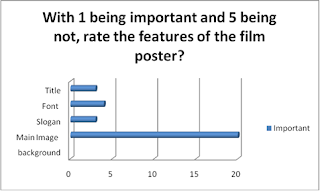
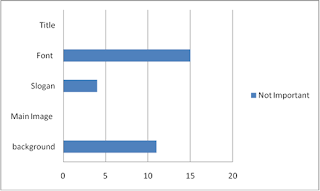
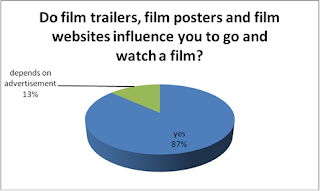
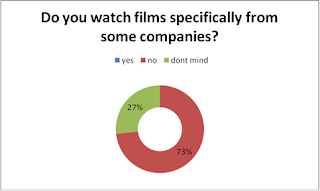
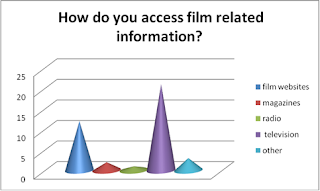
Most popular answers:
· Christian Bale
· Will Smith
· Johnny Depp
· Leonardo Dicaprio
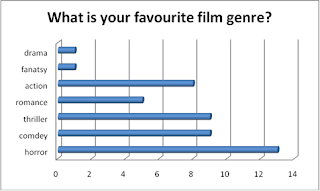
Q14. From your favourite genre, what would you want to feel from watching the film?
Most popular answers:
· Excitement
· suspense
· happy
· satisfied
· entranced
· Scared
· Emotional
· Laughter
· confused
· Fear
· Loved
· surprised
